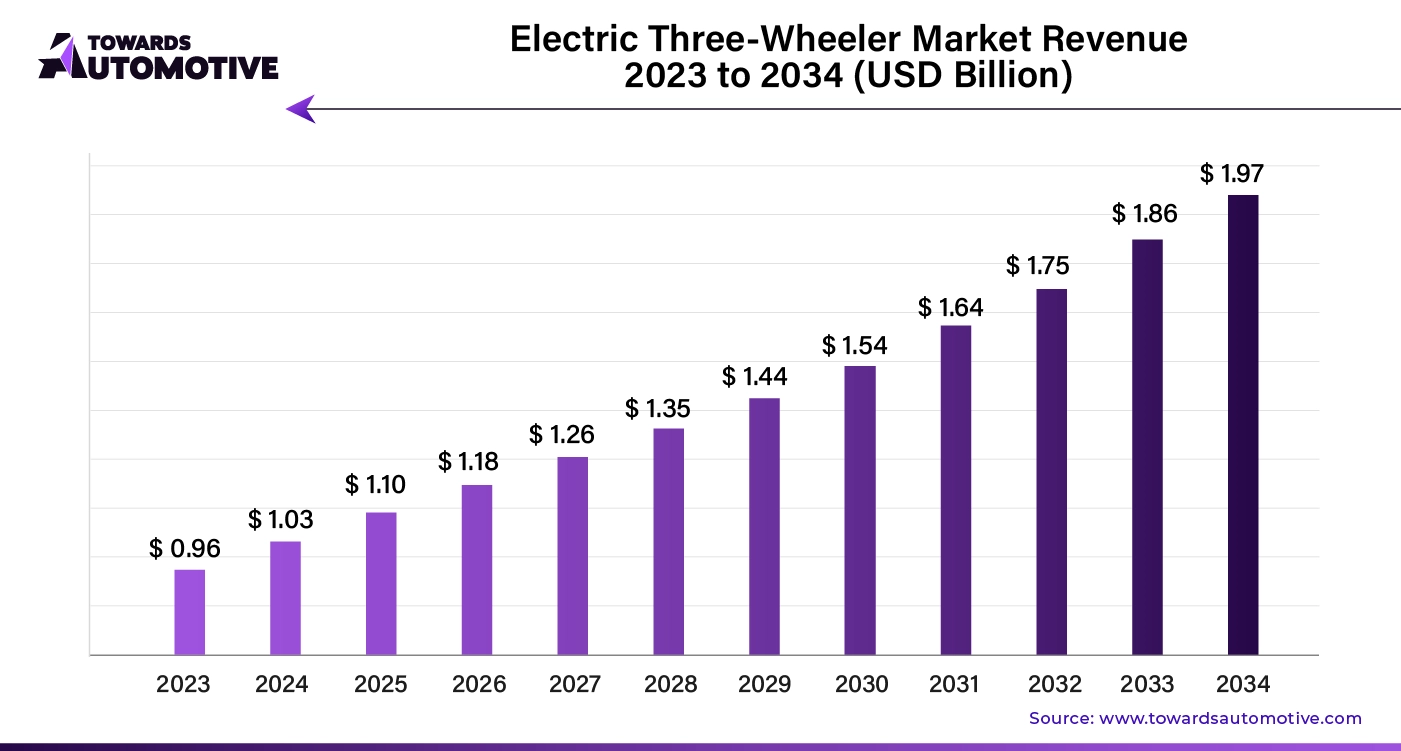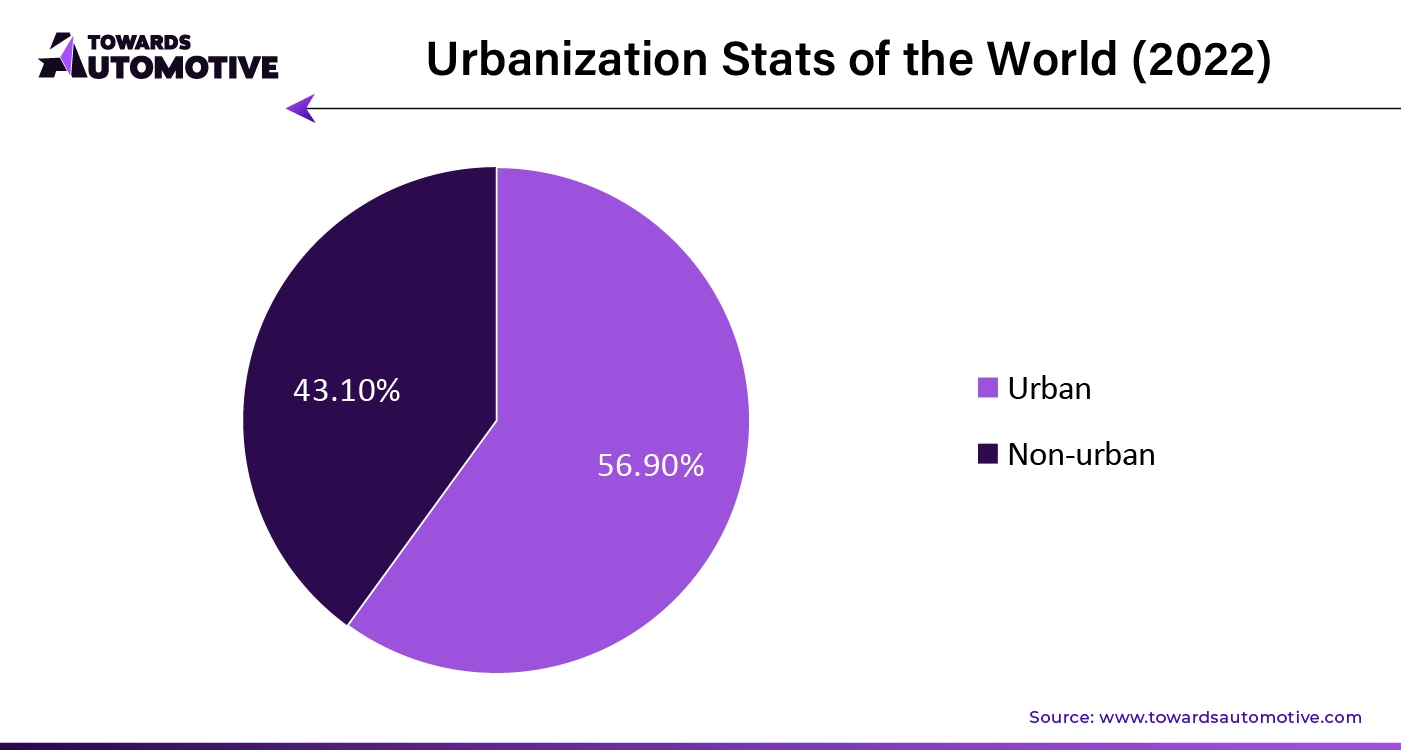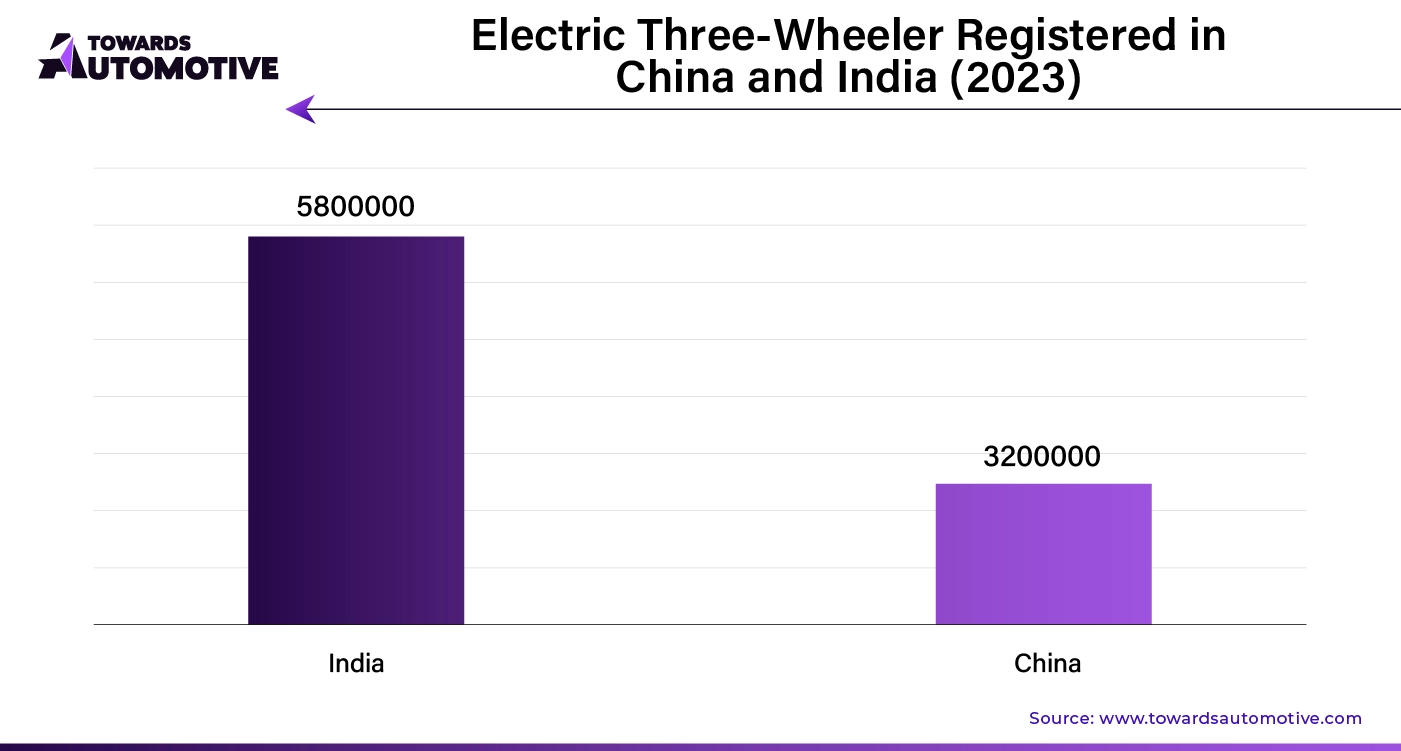April 2025
The global electric three-wheeler market size is calculated at USD 1.03 billion in 2024 and is expected to be worth USD 1.97 billion by 2034, expanding at a CAGR of 7.54% from 2024 to 2034.

Unlock Infinite Advantages: Subscribe to Annual Membership
The electric three-wheeler market is experiencing remarkable growth as it emerges as a key component of the shift towards sustainable urban mobility. Electric three-wheelers, including e-rickshaws and electric scooters, are gaining traction due to their environmental benefits, cost-effectiveness, and suitability for congested urban environments. These vehicles offer a greener alternative to traditional gasoline-powered three-wheelers by producing zero tailpipe emissions, which helps reduce urban air pollution and reliance on fossil fuels.
The growth of the electric three-wheeler market is driven by several factors, including increasing government support through subsidies and incentives for electric vehicle adoption, rising fuel prices, and growing awareness of environmental issues. Additionally, advancements in battery technology and charging infrastructure are making electric three-wheelers more practical and accessible. The shift towards electric three-wheelers is particularly pronounced in developing countries, where they are used extensively for last-mile delivery and public transportation, offering an efficient and affordable solution for both urban and semi-urban areas.
As cities around the world strive for cleaner and more efficient transportation solutions, the electric three-wheeler market is set to play a crucial role in shaping the future of urban mobility, providing a sustainable and cost-effective alternative to conventional three-wheeled vehicles.
Artificial intelligence (AI) is playing a transformative role in the electric three-wheeler market by enhancing vehicle performance, safety, and operational efficiency. AI technologies are increasingly integrated into electric three-wheelers to improve various aspects of their functionality and user experience. For instance, AI-powered systems optimize battery management by predicting charge levels, enhancing battery life, and improving energy efficiency through real-time data analysis. This ensures that electric three-wheelers have better range and reliability, addressing one of the key concerns of potential users.
In terms of safety, AI is utilized for advanced driver assistance systems (ADAS), including features such as collision avoidance, lane-keeping assistance, and adaptive braking. These technologies help mitigate risks and improve the overall safety of electric three-wheelers, making them more attractive to consumers.
AI also plays a significant role in route optimization for fleet operators. By analyzing traffic patterns and predicting optimal routes, AI helps reduce travel time and energy consumption, which is crucial for both delivery services and public transport applications.
Furthermore, AI aids in predictive maintenance by monitoring vehicle performance and identifying potential issues before they lead to failures. This reduces downtime and maintenance costs, enhancing the overall efficiency and reliability of electric three-wheelers in the market.
Urbanization and last-mile connectivity are pivotal factors driving the growth of the electric three-wheeler market. As cities continue to expand and urban populations increase, the demand for efficient, cost-effective transportation solutions becomes more pronounced. Electric three-wheelers, with their compact size and maneuverability, are particularly well-suited for navigating congested urban environments. They offer an agile alternative to traditional vehicles, making them ideal for short-distance travel and quick deliveries in crowded cityscapes.
The need for effective last-mile connectivity—bridging the gap between public transportation hubs and final destinations—further fuels the adoption of electric three-wheelers. These vehicles provide a reliable and eco-friendly solution for completing short trips and delivering goods within urban areas. Their ability to operate efficiently in stop-and-go traffic, coupled with zero tailpipe emissions, aligns with the growing emphasis on reducing urban air pollution and enhancing sustainable transportation options.
Additionally, the low operational and maintenance costs associated with electric three-wheelers make them an attractive choice for businesses involved in logistics and delivery services. As urban areas continue to grow and the focus on sustainable transportation intensifies, electric three-wheelers are positioned to play a crucial role in addressing the challenges of urban mobility and last-mile connectivity.

The electric three-wheeler market faces several restraints that could impact its growth. Key challenges include the high upfront cost of electric vehicles compared to traditional models, limited charging infrastructure in certain regions, and concerns about battery life and range limitations. Additionally, the market's reliance on government subsidies and incentives for adoption may affect its sustainability if such support diminishes. Addressing these obstacles is crucial for realizing the full potential of electric three-wheelers in the global transportation landscape.
Government policies and incentives play a crucial role in shaping the electric three-wheeler market by creating significant opportunities for growth and adoption. Many governments worldwide are implementing supportive measures to encourage the transition from traditional gasoline-powered vehicles to electric alternatives. These measures include subsidies, tax rebates, and grants aimed at reducing the upfront cost of electric three-wheelers, making them more accessible to both consumers and businesses. Additionally, regulations that mandate reductions in vehicle emissions and promote cleaner transportation options further drive the demand for electric three-wheelers.
Government investments in infrastructure, such as expanding charging networks and providing support for research and development, also contribute to the market's growth. These initiatives not only enhance the practicality of electric three-wheelers but also bolster consumer confidence in their reliability and efficiency. By fostering an environment conducive to the adoption of electric vehicles, government policies and incentives are instrumental in accelerating the transition to sustainable transportation solutions, unlocking new market opportunities, and driving the expansion of the electric three-wheeler sector.
The lithium-ion battery segment held the largest share of the market. Lithium-ion batteries are a pivotal driver of growth in the electric three-wheeler market, revolutionizing the sector with their advanced technology and performance benefits. These batteries, known for their high energy density and long cycle life, provide electric three-wheelers with extended driving ranges and improved efficiency compared to traditional lead-acid batteries. The superior performance of lithium-ion batteries reduces the frequency of recharging and extends the operational range of electric three-wheelers.
The rapid advancement in lithium-ion battery technology has led to significant reductions in battery costs, making electric three-wheelers more affordable for consumers and fleet operators. Additionally, the compact and lightweight nature of lithium-ion batteries contributes to the overall design and agility of electric three-wheelers, enhancing their maneuverability and making them well-suited for urban environments.
Furthermore, improvements in battery management systems and thermal management technologies ensure that lithium-ion batteries operate efficiently and safely, even in challenging conditions. These advancements enhance the reliability and longevity of electric three-wheelers, further driving their adoption.
The ongoing innovation in lithium-ion battery technology, including developments in fast-charging capabilities and higher energy densities, continues to bolster the growth of the electric three-wheeler market. As battery technology evolves, it provides a solid foundation for the expansion of electric three-wheelers, supporting their role as a key component in the future of sustainable urban transportation.
The 1000 W to 1500 W segment led the electric three-wheeler market. The 1000 W to 1500 W segment is a significant driver of growth in the electric three-wheeler market, offering a balance of power, efficiency, and affordability that caters to a wide range of applications and consumer needs. This power range is particularly suited for electric three-wheelers used in urban and semi-urban environments, providing sufficient power for daily transportation and commercial activities while ensuring optimal energy efficiency. Vehicles within this power segment are designed to handle typical city traffic, short to medium distances, and varying load capacities, making them ideal for use in passenger transport, goods delivery, and other essential services.
The 1000 W to 1500 W electric three-wheelers benefit from a favorable balance between performance and battery consumption, leading to longer operational ranges and reduced frequency of charging. This efficiency is crucial for both individual users and fleet operators who require reliable and cost-effective transportation solutions. Additionally, the affordability of electric three-wheelers within this power range makes them accessible to a broader audience, including small businesses and low-income users, thereby expanding the market's reach.
The growing adoption of electric three-wheelers in the 1000 W to 1500 W segment is also driven by advancements in battery technology and motor efficiency, which enhance the performance and durability of these vehicles. As urban areas continue to evolve and demand for sustainable transportation solutions increases, the 1000 W to 1500 W segment is poised to play a crucial role in the expansion and success of the electric three-wheeler market.
The passenger carrier segment dominated the industry. The passenger carrier segment is a major catalyst driving the growth of the electric three-wheeler market, reflecting a significant shift towards sustainable urban transportation solutions. Electric three-wheelers designed for passenger transport offer a viable alternative to traditional gasoline-powered rickshaws and taxis, particularly in densely populated cities and urban areas where they are ideal for navigating traffic congestion. Their compact size, coupled with zero tailpipe emissions, makes them an environmentally friendly choice for public transportation and shared mobility services.
The growth in the passenger carrier segment is supported by several factors. First, the increasing emphasis on reducing urban air pollution and greenhouse gas emissions aligns with the adoption of electric three-wheelers, which contribute to cleaner and healthier cities. Second, the rising cost of fuel and maintenance for conventional vehicles drives both operators and consumers to consider more cost-effective and energy-efficient options, with electric three-wheelers offering lower operational costs and reduced maintenance requirements.
Moreover, government incentives and subsidies for electric vehicles, including passenger carriers, further boost market growth by making these vehicles more financially accessible. Advances in battery technology and charging infrastructure also enhance the practicality and attractiveness of electric passenger carriers, improving range, reducing charging times, and supporting the widespread adoption of these vehicles. As urban areas continue to expand and the demand for sustainable transportation solutions grows, the passenger carrier segment of the electric three-wheeler market is positioned to experience robust growth and play a pivotal role in shaping the future of urban mobility.
Asia Pacific dominated the electric three-wheeler market. The electric three-wheeler market in Asia Pacific is experiencing robust growth driven by a confluence of environmental concerns, emerging startups, technological advancements, and infrastructure development. As urban areas in the region grapple with increasing pollution levels and environmental degradation, electric three-wheelers offer a cleaner alternative by producing zero tailpipe emissions. This environmental benefit resonates strongly with both consumers and governments focused on sustainable development and air quality improvement.
Startups are playing a crucial role in this growth by introducing innovative electric three-wheeler designs and business models that cater to the diverse needs of the region. These new entrants are not only enhancing vehicle performance and affordability but are also creating new market dynamics and stimulating competition.
Technological advancements further bolster the market by improving battery efficiency, extending vehicle range, and reducing charging times. Breakthroughs in battery technology and electric drivetrains enhance the overall viability and attractiveness of electric three-wheelers, making them a practical choice for urban mobility.
Infrastructure development is equally vital, as expanding charging networks and support facilities enhance the usability and convenience of electric three-wheelers. Investments in both urban and rural charging infrastructure ensure that these vehicles can operate seamlessly across various locations.

Europe is expected to grow with a notable CAGR during the forecast period. The electric three-wheeler market in Europe is significantly driven by growing urbanization, the expansion of charging infrastructure, and increasing consumer awareness and demand. As European cities continue to expand and experience higher population densities, the need for efficient and sustainable urban transportation solutions becomes more pressing. Electric three-wheelers, with their compact size and zero-emission operation, are ideally suited for navigating congested city streets and providing effective last-mile connectivity, making them an attractive option for both personal and commercial use.
The expansion of charging infrastructure across Europe plays a crucial role in supporting the growth of the electric three-wheeler market. With increased investments in public and private charging stations, the accessibility and convenience of charging these vehicles have improved, addressing range anxiety and facilitating broader adoption. This infrastructure development ensures that users can easily charge their electric three-wheelers, thereby enhancing their practicality and reliability.
Consumer awareness and demand for eco-friendly transportation solutions are also key drivers of market growth. As Europeans become more conscious of environmental issues and the benefits of reducing carbon emissions, there is a growing preference for electric vehicles. The lower operational costs and reduced environmental impact of electric three-wheelers align with these consumer values, leading to higher adoption rates.
By Battery Type
By Power
By End-Use
By Region
April 2025
April 2025
April 2025
April 2025
We offer automotive expertise for market projections and customizable research, adaptable to diverse strategic approaches.
Contact Us